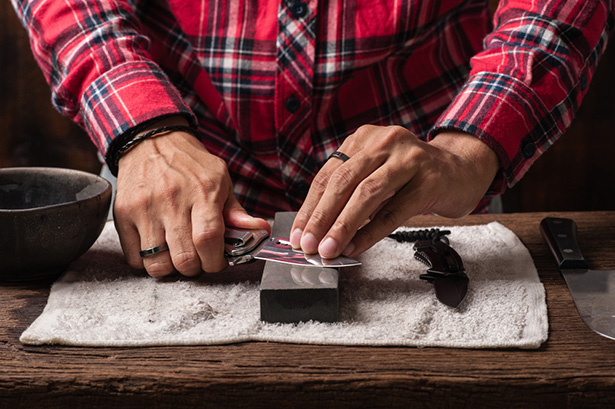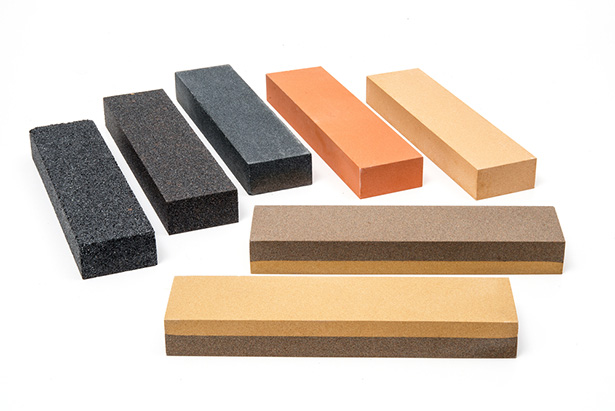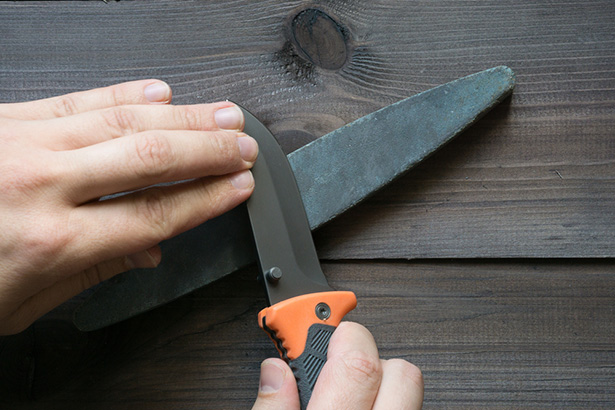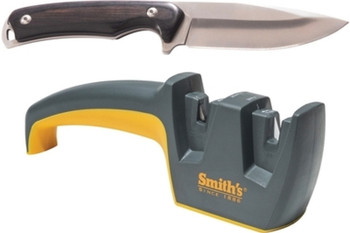How to Sharpen a Pocket Knife with a Stone
Apr 18th 2019

A dull knife is a dangerous knife and also makes your blade less effective. Stones are a common and time-honored way of sharpening knives, and getting the perfect edge on your knife doesn’t require much practice if you have the right materials. Use this guide to get the best results so you can cut materials safely and accurately.
Which stone should I use?
In decades past, natural stones, oil stones and ceramic stones were used for sharpening knives. Ceramic stones are still popular, but their quality varies dramatically between brands. They also require soaking in water for around 10 minutes before use.
Improvements in modern engineering have made diamond-coated stones and plates more affordable, but these stones run the risk of sharpening a knife too quickly and causing damage. Unless you need extreme sharpness, another type of stone will get the job done.
Find the Best Pocket Knife to Fit Your Needs
Synthetic stones provide an optimal balance of strength and ease of use. They usually require a little water or oil for lubrication to prevent damage, but they deliver exceptional, long-lasting results.

Rough vs. fine grit
Like with sandpaper, sharpening stones are assigned a number to show the fineness of their grit. However, the scale used for sharpening stones is not the same as the scale for sandpaper and can even vary between brands. Sharpening stones range from 120 grit to over 3,000 grit, with higher grit being finer and slower to sharpen.
Many sharpening stones have two surfaces, each with different abilities. The rougher side of the stone has a coarser grit that grinds the metal down quickly. The fine grit side hones the blade to get a razor-sharp edge.
Using lubricant
Sharpening a knife generates friction which, consequently, creates heat. Too much heat can warp your blade, so it’s important to reduce that heat by either working more slowly or using a lubricant.
Lubrication also washes away the small, grainy debris, called swarf, that is produced when you sharpen a knife. Swarf can corrode, scratch or chip your blade if not removed as you sharpen.
Some types of stones don’t require any oil or water, so pay close attention to the manufacturer’s directions for use. A stone that requires oil-based lubricant won’t work with water, and vice versa. Since mineral oil and water are cheap and readily available, keep some on hand for use every time you sharpen a knife if your stone requires it.
Purchase a Pocket Knife Storage Kit Today! .ctaBtn {background:#000;color:#fff;display:table;margin:0 auto;padding:20px;font-weight:700;border:1px solid #000;text-align:center;text-decoration:none;}.ctaBtn:hover {background:#fff;color:#000;}
The sharpening process
- When you’re ready to sharpen your knife, start with the rough grit side of the stone. If you cannot tell the rough from the smooth side, drag your thumbnail across the surface to find the rougher texture. Apply enough lubricant to coat the entire surface of the stone, but not too much that it drips over the sides.
- Gently pull the knife edge backward along the rough grit stone, moving from the heel to the tip in a sweeping motion. Keep the knife at about a 20-degree angle to the stone’s surface. This gives you an edge that is ideally suited to everyday tasks. Various styles of knife require different sharpening angles. Consult your knife’s manufacturer for a recommendation.
- Repeat this motion five times on each side of the blade, using light, even pressure to keep the knife against the stone.
- Switch to a fine grit stone and repeat the motion a few more times. If the stone is working properly, you should be able to feel fine burrs coming out of the metal.
- Once the knife is sharp, carefully wipe away the lubricant and the last of the burrs. If using water as a lubricant, ensure the knife is completely dry or apply a fine coat of mineral oil to the blade before storage.
- Store the knife in a pocket knife storage kit to reduce the risk of damage and general wear and tear from the environment.

How long do pocket knives stay sharp?
Even the best pocket knifeshould be resharpened every two to four uses if they are made of steel, and after every use if they are made of carbon steel. They typically require more frequent sharpening than kitchen knives because they are often used to cut wood, rope and other tough objects.
Keep in mind that honing and sharpening are two different tasks. Honing is the act of straightening a blade, including straightening the tiny dents that can occur during everyday use. High-quality custom knives are strong enough to resist these dents, so they will usually require sharpening instead of honing.
Make sharpening part of your basic routine to keep your knife in good condition. It’s also important to keep your knife free of debris and dirt that can cause corrosion and damage, so take the time to learn how to clean a pocket knife the right way.
Custom knives that last
eKnives specializes in high-quality custom knives that can hold up to years of wear and tear. We carry straight and serrated blades from a number of well-respected knife manufacturers. Whether you’re a seasoned knife enthusiast or are just starting to learn how to use knives, we carry knives that are attractive, functional and easy to use. Call (423) 525-9477 to find out more about our range of high-quality knives and custom blades.

